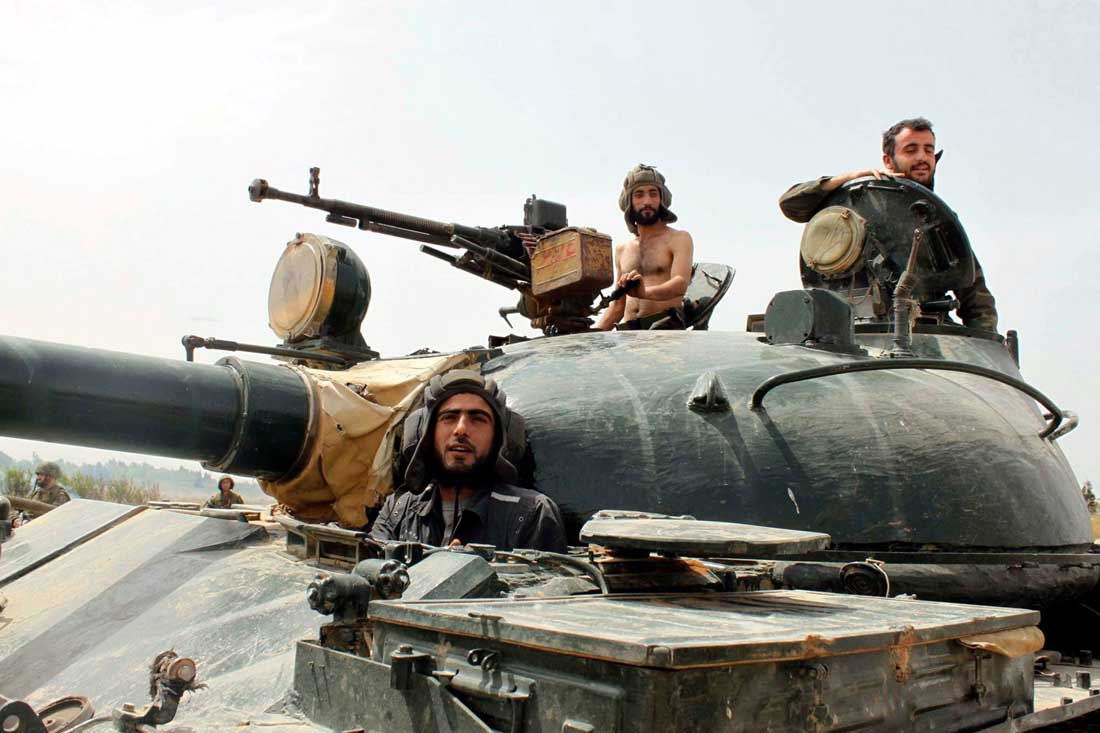The T-62, a technological marvel at its time of inception because of its advanced 115mm smoothbore tank gun. Nevertheless, the tank inherited much of the T-55's problems and even introduced a host of new problems to boot. The 115mm gun, once feared by NATO, became redundant when more modern ammuniton for the T-55's 100mm gun came available. This combined with the horrendous fire rate of just four rounds a minute made the T-62 somewhat of a black sheep later on in its career.
Apart from Bulgaria, Warsaw Pact countries were all but interested in the T-62, and opted for the procurement of more T-55s instead. The tank was widely exported to Soviet client states in the Middle East and North Africa however. Egypt and Syria were keen on testing the T-62 in combat and subsequently used them in the 1973 Yom Kippur war, where it performed below expectations.
Syria is believed to have received up to 800 T-62s in the late sixties and throughout the seventies. Of these, a little under 500 are still believed to be operational, in reserve or stored. An additional batch of 300 T-62s supposedly delivered in 1982 was misreported and actually consisted of T-72As instead. In similar fashion, a batch of 200 T-62s delivered by Libya in the late seventies is sometimes reported but cannot be independently confirmed.[1]
Both the T-62 Model 1967 and T-62 Model 1972 were delivered to Syria, of which the Model 1972 is the most numerous in Syrian service. It comes with a 12.7mm DshK heavy machine gun for increased protection against air threats or possible use against ground targets, something which the Model 1967 lacked.
The T-62 fleet also saw action in the 1982 war, and while the Syrian tank fleet performed better than in the 1973 war, it lost around 200 T-62s to Israeli infantry, tanks and helicopters. Much more successful were the dedicated hunter-killer anti-tank teams armed with RPG-7s, RPG-18s, 9K111 Fagots and MILANs. Operating in and around Beirut, they used narrow streets to their full advantage.
Interestingly, one Syrian T-62 Model 1967 ended up with the South African Defence Force, which already operated a squadron of PT-76s and T-55s for OPFOR (opposing force) training and evaluation for possible future encounters with these tanks in Angola.
Contrary to Syria's T-55s, the T-62s never received any large-scale upgrade programs to improve their combat capabilities. Instead, a part of the T-62 fleet was stored in the 90s. The T-62s that remained operational were all stationed far away from the occupied Golan Heights and were mostly operated by reserve units.
A small scale upgrade program did see a few T-62s enhanced by the addition of a wind sensor. As the amount of upgraded tanks was so low, they likely featured as protypes for a possible future upgrade program which never saw light. At least one of these tanks was captured by rebels during the Syrian Civil War. The tank, which can be seen below, is decorated by two texts that read بشار - Bashar and منحبك يا بشار - We love you Bashar.
The Syrian Civil War marked the third combat debut of the T-62 in Syrian service. Most remain operated by the Syrian Arab Army, with some tanks permanently detached to the National Defence Force (NDF) and Suqur al-Sahara (Desert Falcons). A part of the T-62 fleet remains stored as a strategic reserve. This means the Syrian government can still call upon a few hundred tanks to replace combat losses, a comfortable thought for the Syrian Arab Army as the tank fleet continues to shrink.
A couple of T-62s saw heavy use at Tabqa where they covered the runway for long enough to allow the remaining operational aircraft and helicopters to depart the airbase. Other T-62s are involved in Suqur al-Sahara's offensives in the desert, although it's unknown if these tanks have come under the command of Suqur al-Sahara or if they remain under Syrian Arab Army control.
A small number of T-62s have received local armour additions, these upgrades usually depend on how much effort has been put into it by the operators and vary from everything from the example seen below to simple sandbags. While such provisional adaptations might have some use against your standard RPG round, it is unlikely that they will aid the T-62 in withstanding the highly volatile anti-tank climate of the Syrian battlefield.
As the war keeps eroding Syria's fleet of steel beasts and operational numbers continue to dwindle, the T-62 is likely to play an ever larger role in its most challenging conflict yet.
Recommended Articles
Syria's Steel Beasts: The T-55






